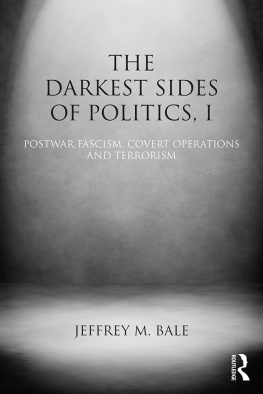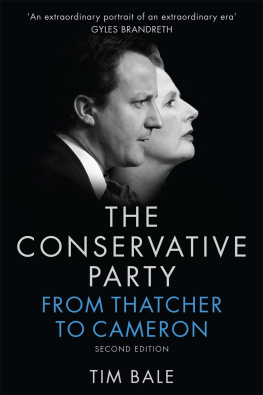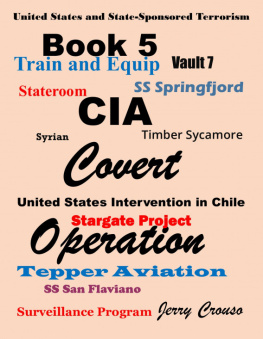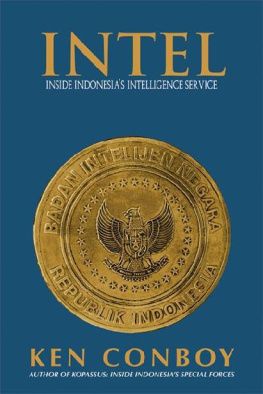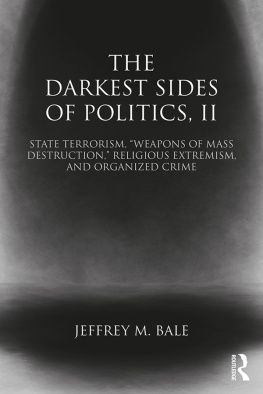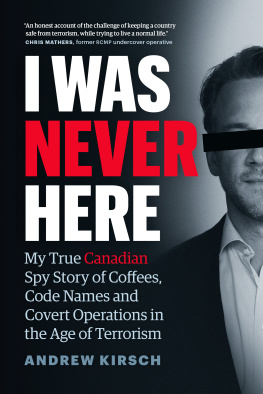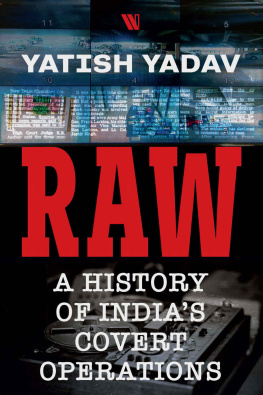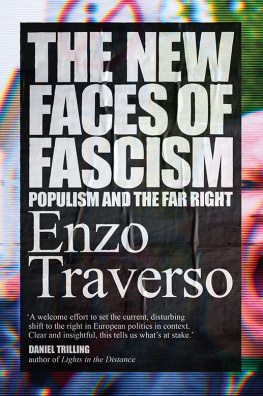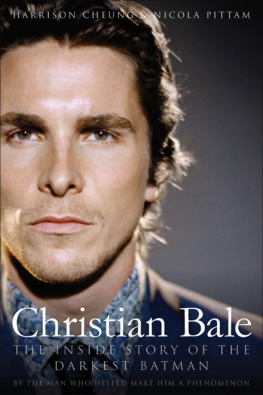Bale - The darkest sides of politics, I: Postwar Fascism, Covert Operations, and Terrorism
Here you can read online Bale - The darkest sides of politics, I: Postwar Fascism, Covert Operations, and Terrorism full text of the book (entire story) in english for free. Download pdf and epub, get meaning, cover and reviews about this ebook. City: London;New York, year: 2018, publisher: Taylor & Francis (CAM);Routledge Taylor & Francis Group, genre: Politics. Description of the work, (preface) as well as reviews are available. Best literature library LitArk.com created for fans of good reading and offers a wide selection of genres:
Romance novel
Science fiction
Adventure
Detective
Science
History
Home and family
Prose
Art
Politics
Computer
Non-fiction
Religion
Business
Children
Humor
Choose a favorite category and find really read worthwhile books. Enjoy immersion in the world of imagination, feel the emotions of the characters or learn something new for yourself, make an fascinating discovery.
The darkest sides of politics, I: Postwar Fascism, Covert Operations, and Terrorism: summary, description and annotation
We offer to read an annotation, description, summary or preface (depends on what the author of the book "The darkest sides of politics, I: Postwar Fascism, Covert Operations, and Terrorism" wrote himself). If you haven't found the necessary information about the book — write in the comments, we will try to find it.
Bale: author's other books
Who wrote The darkest sides of politics, I: Postwar Fascism, Covert Operations, and Terrorism? Find out the surname, the name of the author of the book and a list of all author's works by series.
The darkest sides of politics, I: Postwar Fascism, Covert Operations, and Terrorism — read online for free the complete book (whole text) full work
Below is the text of the book, divided by pages. System saving the place of the last page read, allows you to conveniently read the book "The darkest sides of politics, I: Postwar Fascism, Covert Operations, and Terrorism" online for free, without having to search again every time where you left off. Put a bookmark, and you can go to the page where you finished reading at any time.
Font size:
Interval:
Bookmark:
First published 2018
by Routledge
2 Park Square, Milton Park, Abingdon, Oxon OX14 4RN
and by Routledge
711 Third Avenue, New York, NY 10017
Routledge is an imprint of the Taylor & Francis Group, an informa business
2018 Jeffrey M. Bale
The right of Jeffrey M. Bale to be identified as author of this work has been asserted by him in accordance with sections 77 and 78 of the Copyright, Designs and Patents Act 1988.
All rights reserved. No part of this book may be reprinted or reproduced or utilised in any form or by any electronic, mechanical, or other means, now known or hereafter invented, including photocopying and recording, or in any information storage or retrieval system, without permission in writing from the publishers.
Trademark notice: Product or corporate names may be trademarks or registered trademarks, and are used only for identification and explanation without intent to infringe.
British Library Cataloguing-in-Publication Data
A catalogue record for this book is available from the British Library
Library of Congress Cataloging-in-Publication Data
A catalog record for this book has been requested
ISBN: 978-1-138-78560-1 (hbk)
ISBN: 978-1-138-78561-8 (pbk)
ISBN: 978-1-315-76611-9 (ebk)
Typeset in Bembo
by Apex CoVantage, LLC

The materials collected in the two volumes of this book derive from a variety of sources. Most have already been published in academic works or journalistic magazines devoted to extremism, terrorism, and covert politics, whereas others originated as chapters from my doctoral dissertation at the University of California at Berkeley, two were especially prepared for contractors for agencies of the U.S. government and have not yet been published, and one was written initially for another book. The reader should be warned, however, that most of the materials herein are examples of old school historical scholarship, which means that they are densely packed with rich, empirical details, are based as much as possible on a careful evaluation of the existing corpus of primary sources, and contain very extensive reference notes. Thus those who have become accustomed to reading modern social science literature, with its excessive emphasis on theories and models, obsession with quantification, and embarrassingly limited use of primary sources, may find some of them rough going. On the other hand, traditional historians should feel themselves right at home. That is entirely intentional.
The introductory chapter was mostly prepared for a separate book-length study (provisionally titled Where the Anti-democratic Extremes Touch: Patterns of Interaction and Collaboration between Islamist Networks and Western Left- and Right-Wing Extremists ) that I had planned and begun to write. However, the emotional fallout from the sudden death of my longtime girlfriend interrupted the process of writing that book, which therefore may never be written. Hence I have added some new prefatory paragraphs to a chapter focusing on the nature and importance of extremist ideologies.
The second chapter was first published in the 1990s in Lobster: A Journal of Parapolitics , and then expanded and republished in the academic journal Patterns of Prejudice .
. I am very pleased and proud to say that my detailed reconstructions and close analyses of these murky events over three decades ago proved to be extremely accurate and indeed prescient, because the new information that has subsequently appeared has not only confirmed, but further reinforced, virtually all of my narrative accounts and conclusions. This goes to show, yet again, that comprehensive scholarly research generally stands the test of time, unlike the trendy, fashionable theoretical drivel that too many people in the humanities and social sciences have been peddling in recent decades.
was originally published in the Bulletin of the Turkish Studies Association , and then republished sometime later in Lobster so that it would reach a specialized non-academic audience. It has been slightly amended.
was previously published in Patterns of Prejudice . It has not been altered.
Chapter 1 originally appeared in an edited volume titled Making Sense of Proxy Wars , edited by Michael Innes. It has not been altered.
Chapter 2 was published in the journal Democracy and Security . I am happy to say that the fears of many analysts (myself included) that some toxic chemical or biological agents produced in connection with Project Coast may have been smuggled out of South Africa appear not to have materialized. The reconstruction of the actual details of this covert program, including special operations assassinations carried out with the use of these agents, has proven to be accurate. It has not been altered.
Chapter 3 was originally written for a graduate seminar course at the University of California at Berkeley and then published in Lobster . It has been slightly amended and updated.
Chapter 4 is an unpublished report that I prepared under contract for a U.S. government entity. It contains no classified information.
Chapter 5 was first published as a chapter in a book titled Jihadists and Weapons of Mass Destruction , edited by Gary Ackerman and Jeremy Tamsett. It has been slightly altered.
Here I would like to emphasize that I would have preferred to devote most of my research efforts in recent years to reconstructing particular jihadist terrorist plots and attacks, on the basis of an in-depth examination of judicial materials and other primary sources, which is the same methodology I employed for many years while doing research on neo-fascist terrorism. I did indeed adopt those tried-and-true methods in connection with both the 1999 Ahmad Rassam Millennium bomb plot (see Chapter 9 in this volume) and the 2004 Madrid train bombings (in a monograph titled Jihdist Cells and I.E.D. Capabilities in Europe: Assessing the Present and Future Threat to the West , which was published by the United States Army War Colleges Strategic Studies Institute in 2012). Unfortunately, given the proliferation of ill-informed nonsense being peddled after 9/11 by so many newly minted terrorism experts, most of whom had no prior academic background in the study of terrorism, Islamic history, Islamic religious and legal doctrines, or Islamist ideologies and movements, I increasingly felt compelled to try to promote more conceptual clarity about these broader issues. This seemed all the more necessary because nave and erroneous ideas about Islam and Islamism were exerting an ever-growing influence on the counterterrorism policies adopted by the United States and other Western nations, with predictably disastrous real-world consequences.
The next three articles included herein were therefore designed to counter widespread but misleading claims that (a) Islam is inherently a religion of peace (despite numerous Quranic sura s that explicitly enjoin warfare against non-believers, Muhammads own exemplary behavior as a warlord, and centuries of brutal Muslim conquests of infidel territory); that (b) Islamism, an intrinsically literalist, strict, and puritanical but in most respects orthodox interpretation of core Islamic doctrines, can be moderate with respect to its goals (as opposed to its methods); that (c) jihadist terrorism has nothing to do with Islam despite the fact that its Islamist sponsors and perpetrators correctly insist otherwise (and, indeed, obsessively cite canonical Islamic sources in order to justify every action they take); and that (d) Western counterterrorist policies should be based on promoting these absurd revisionist fictions instead of acknowledging reality. In these three chapters, my growing exasperation about the Wests stubborn refusal to recognize or acknowledge the nature of our Islamist adversaries is at times on display. Then again, this sort of denial of reality is rarely if ever a problem when one writes about fascism and neo-fascism. Although Islamist apologists are currently omnipresent in academia (and the media), as are communist apologists and cult apologists, fascist apologists have fortunately not been common there since the 1920s and 1930s. How does one explain the seemingly never-ending willingness of supposedly educated people to engage in such embarrassing apologetics for totalitarian ideologies and movements? As George Orwell once wryly noted, [t]here are some ideas so absurd that only an intellectual could believe them. American literary critic Lionel Trilling helped to explain why when he observed that [t]hose members of the intellectual class who prided themselves upon their political commitment were committed not to the fact but to the abstraction. Sadly, this is no less true today.
Font size:
Interval:
Bookmark:
Similar books «The darkest sides of politics, I: Postwar Fascism, Covert Operations, and Terrorism»
Look at similar books to The darkest sides of politics, I: Postwar Fascism, Covert Operations, and Terrorism. We have selected literature similar in name and meaning in the hope of providing readers with more options to find new, interesting, not yet read works.
Discussion, reviews of the book The darkest sides of politics, I: Postwar Fascism, Covert Operations, and Terrorism and just readers' own opinions. Leave your comments, write what you think about the work, its meaning or the main characters. Specify what exactly you liked and what you didn't like, and why you think so.

